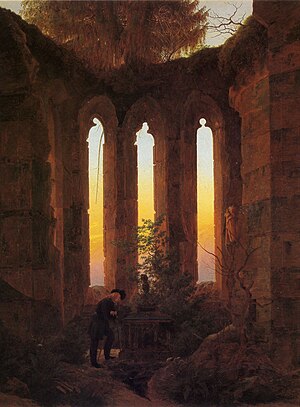August Milarch
August Alexander Ferdinand Milarch (born July 11, 1786 in Falkenburg (Pomerania) , † June 13, 1862 in Schönbeck ) was a German Lutheran theologian, high school professor, officer in the Wars of Liberation and pastor. Milarch is a figurehead in the painting Hutten's grave by the painter Caspar David Friedrich .
Life
August Milarch was the son of an administrator who died early. He attended the orphanage school in Halle and studied Protestant theology at the University of Halle from 1804 to 1806 . In 1807 Milarch succeeded Friedrich Ludwig Jahn as tutor at Baron le Fort in Neubrandenburg .
From 1810 he was a teacher at the Neubrandenburg School of Academics and in 1813 became its vice-principal. In the same year Milarch joined the Mecklenburg Hussar Regiment with the majority of his Primaner and took part in the Wars of Liberation against Napoleon first as a portepee - ensign , then after the battle of the Katzbach as a lieutenant and quartermaster . For his service in the Battle of Leipzig he received the Russian Order of St. Vladimir 4th class with the ribbon and the Iron Cross .
After his return, Milarch became a (high school) professor and, in 1830, rector of the scholarly school in Neubrandenburg. In 1815/1816 Milarch was a pioneer of the gymnastics movement in Neubrandenburg and continued the gymnastics that Jahn had started in Neubrandenburg. He was a speaker at the Reformation Festival in 1817 and in 1838 at the anniversary celebrations on the occasion of the Wars of Liberation. Despite the Karlovy Vary resolutions, Milarch fought to continue gymnastics until 1832.
In 1833 he was appointed pastor of the Evangelical Lutheran parish of Schönbeck with Lindow (now part of Groß Miltzow ) and Cosabroma (now part of Friedland (Mecklenburg) ). On his 50th anniversary in service (1862), Milarch was appointed to the church council. On October 18, 1863, a plaque made of white marble was unveiled in the St. Marienkirche in Neubrandenburg in memory of Milarch and his Primaner, with whom he had participated in the wars of liberation [loss of war in 1945].
Milarch had been married to Adolphine (Hedwig) Brückner (* March 29, 1788, † August 12, 1838), a daughter of the doctor and councilor Adolf (Friedrich Theodor) Brückner (1744–1823, brother of the writer Ernst ( Theodor Johann) Brückner ) in Neubrandenburg and his wife Ernestine (Clara Marie Sophie Hedwig), b. Lemcke (1758-1827). He had four children:
- Ida (1819–1901), married to prepositus Ernst Bahr († 1885) in Woldegk
- Clara († 1891 unmarried)
- Marie, married to Pastor Johann Heinrich Franz Beyer (1827–1887) in Neddemin since 1852
- Ernst (born January 29, 1829 in Neubrandenburg; died May 26, 1888 ibid), prepositus in Neubrandenburg.
A street in Neubrandenburg was named after him August-Milarch-Straße .
Milarch and Caspar David Friedrich
Milarch was related to the painter Caspar David Friedrich since 1816 . Friedrich's brother, Adolf, had married Margarete Brückner in 1801, a cousin of Adolphine (Hedwig) Brückner, later Milarch's wife. Friedrich set a monument to Milarch, who was celebrated as the hero of the War of Liberation, in his painting Hutten's Grave in 1823 .
The painter had recorded Milarch as a warrior in uniform with a camera obscura , the plot of which was preserved. In 1859 August Milarch was one of the first people in Neubrandenburg to be photographed with the new technique of photography in the studio of the painter and photographer Wilhelm Bahr (1821–1876), so that today the view of a figure from Friedrich's picture staff is preserved in the photo.

|
| Hutten's grave |
|---|
| Caspar David Friedrich |
| Oil on canvas |
| 73 × 93 cm |
| Classic Foundation Weimar |
Works
- Speech for the school celebration on the jubilee of the church reform on November 1st, 1817 in Neubrandenburg in the St. Johanniskirche. 1817.
- Reviews and reports. Concerning the works of art. About PH. O. Rungs's four times. Berlin 1821.
- Thoughts on the return of the worship service on October 18, 1823.
- Sermon on New Year's Day 1834 about Ev. Luc. 2, v. 21. Neubrandenburg 1834.
- Sermon on Victory Day 1843 on Psalm 107, v. 21.22.
- The five and twenty years of remembrance and jubilation of the former Mecklenburg-Strelitz Hussar Regiment, on the day of the appeal, March 30, 1838 in Neustrelitz: along with the speeches held by Pastors Milarch, Denzin, Giesebrecht and Jacobi. Dümmler, Neustrelitz 1838.
- (anonymous) Memorabilia of the Mecklenburg-Strelitz Hussar Regiment in the years of the liberation struggle from 1813 to 1815. Brünslow, Neubrandenburg 1854. ( digitized version )
literature
- Georg Krüger: The pastors in Stargard since the Reformation. In: Yearbooks of the Association for Mecklenburg History and Archeology . Volume 69 (1904), pp. 1-270. Digitized
Web links
- Literature about August Milarch in the state bibliography MV
- Works by August Milarch in the state bibliography MV
Individual evidence
- ↑ Detlef Stapf: Caspar David Friedrichs hidden landscapes. The Neubrandenburg contexts . Greifswald 2014, network-based P-Book
| personal data | |
|---|---|
| SURNAME | Milarch, August |
| ALTERNATIVE NAMES | Milarch, August Alexander Ferdinand (full name) |
| BRIEF DESCRIPTION | German teacher and pastor |
| DATE OF BIRTH | July 11, 1786 |
| PLACE OF BIRTH | Falkenburg (Pomerania) |
| DATE OF DEATH | June 13, 1862 |
| Place of death | Schönbeck |


